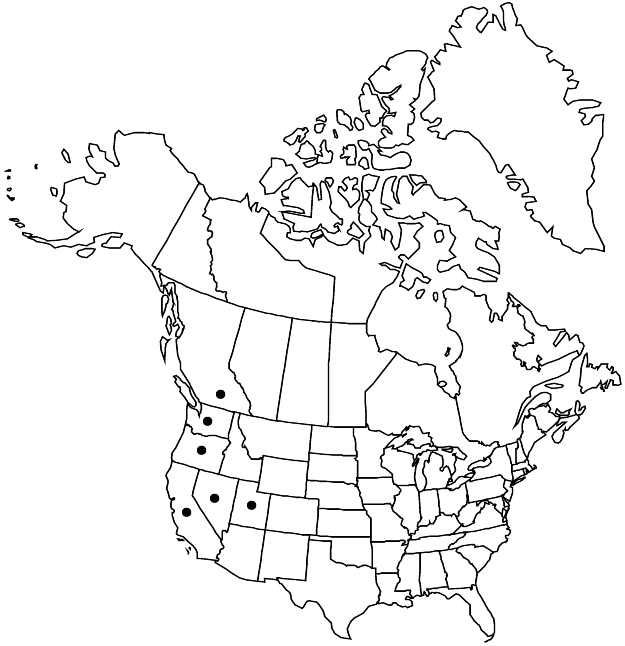Difference between revisions of "Eriogonum ovalifolium var. nivale"
Contr. W. Bot. 11: 8. 1903.
FNA>Volume Importer |
FNA>Volume Importer |
||
| Line 30: | Line 30: | ||
|elevation=1700-4200 m | |elevation=1700-4200 m | ||
|distribution=B.C.;Calif.;Nev.;Oreg.;Utah;Wash. | |distribution=B.C.;Calif.;Nev.;Oreg.;Utah;Wash. | ||
| − | |discussion=<p>Variety nivale is the common high-elevation expression of the species in desert ranges of the Great Basin and in the Sierra-Cascade cordillera. In northwestern Washington, some plants of var. nivale have scapes to 13 cm (especially in Chellam County). They are well removed from var. purpureum, and have the dense, almost brilliant white tomentum of var. nivale. Plants in the Slide Mountain-Mt. Rose area of west-central Nevada occasionally have the brown leaf margins more commonly seen in the lower-elevation var. eximium. A few populations having off-yellowish flowers are known from the White Mountains of Inyo and Mono counties, California. There as well, the tepals are distinctly marked by a large red midrib. This is similar to the condition found in Eriogonum gilmanii, but in the White Mountains plants the tepals are not globose as in that species nor is the pubescence similar. The variety is ideal for the rock garden and is widely available for cultivation.</p> | + | |discussion=<p>Variety nivale is the common high-elevation expression of the species in desert ranges of the Great Basin and in the Sierra-Cascade cordillera. In northwestern Washington, some plants of <i></i>var.<i> nivale</i> have scapes to 13 cm (especially in Chellam County). They are well removed from <i></i>var.<i> purpureum</i>, and have the dense, almost brilliant white tomentum of <i></i>var.<i> nivale</i>. Plants in the Slide Mountain-Mt. Rose area of west-central <i>Nevada</i> occasionally have the brown leaf margins more commonly seen in the lower-elevation <i></i>var.<i> eximium</i>. A few populations having off-yellowish flowers are known from the White Mountains of Inyo and Mono counties, California. There as well, the tepals are distinctly marked by a large red midrib. This is similar to the condition found in <i>Eriogonum gilmanii</i>, but in the White Mountains plants the tepals are not globose as in that species nor is the pubescence similar. The variety is ideal for the rock garden and is widely available for cultivation.</p> |
|tables= | |tables= | ||
|references= | |references= | ||
| Line 54: | Line 54: | ||
|publication year=1903 | |publication year=1903 | ||
|special status= | |special status= | ||
| − | |source xml=https://jpend@bitbucket.org/aafc-mbb/fna-data-curation.git/src/ | + | |source xml=https://jpend@bitbucket.org/aafc-mbb/fna-data-curation.git/src/8f726806613d60c220dc4493de13607dd3150896/coarse_grained_fna_xml/V5/V5_654.xml |
|subfamily=Polygonaceae subfam. Eriogonoideae | |subfamily=Polygonaceae subfam. Eriogonoideae | ||
|genus=Eriogonum | |genus=Eriogonum | ||
Revision as of 17:40, 18 September 2019
Plants 0.5–3 dm wide. Leaf blades usually round, 0.2–0.8 cm, densely lanate to white-tomentose, margins infrequently brownish. Scapes mostly erect, 0.3–5(–13) cm, mostly lanate or tomentose. Inflorescences capitate, 1–2.5 cm wide; branches absent. Involucres 2–4 per cluster, 3–4.5 mm. Flowers 4–5 mm; perianth white to rose or red. 2n = 40.
Phenology: Flowering Jun–Sep.
Habitat: Sandy to gravelly often granitic slopes, ridges, and alpine fell-fields, mixed grassland, mountain meadow, and sagebrush communities, conifer woodlands
Elevation: 1700-4200 m
Distribution

B.C., Calif., Nev., Oreg., Utah, Wash.
Discussion
Variety nivale is the common high-elevation expression of the species in desert ranges of the Great Basin and in the Sierra-Cascade cordillera. In northwestern Washington, some plants of var. nivale have scapes to 13 cm (especially in Chellam County). They are well removed from var. purpureum, and have the dense, almost brilliant white tomentum of var. nivale. Plants in the Slide Mountain-Mt. Rose area of west-central Nevada occasionally have the brown leaf margins more commonly seen in the lower-elevation var. eximium. A few populations having off-yellowish flowers are known from the White Mountains of Inyo and Mono counties, California. There as well, the tepals are distinctly marked by a large red midrib. This is similar to the condition found in Eriogonum gilmanii, but in the White Mountains plants the tepals are not globose as in that species nor is the pubescence similar. The variety is ideal for the rock garden and is widely available for cultivation.
Selected References
None.